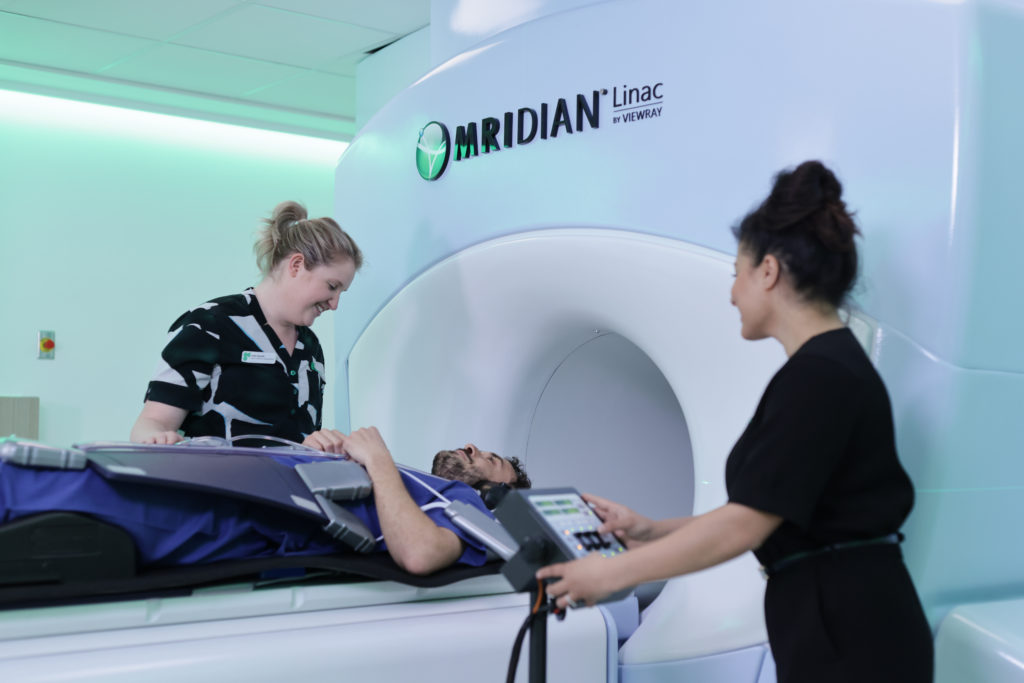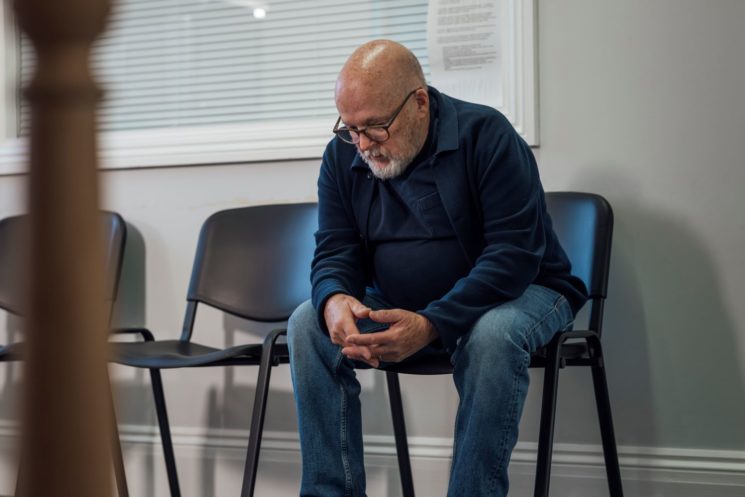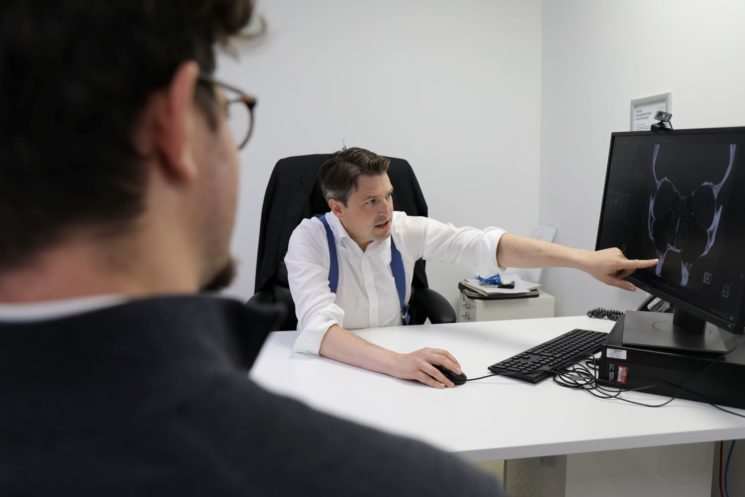
The MRIdian MR Linac is an advanced radiotherapy technology that delivers treatment to tumours more accurately than other types of radiotherapy machines. With its unique functionality, treatment can be delivered over fewer treatment sessions and with fewer side effects.
In partnership with GenesisCare, we became the first private hospital in the UK to provide patients with access to the MRIdian as part of our Integrated Cancer Campus approach.
We spoke to Dr Andrew Gaya, Consultant Clinical Oncologist at Cromwell Hospital, to learn more about this innovative cancer treatment option.

What is MRIdian MR Linac?
The MRIdian MR Linac is a machine that uses a combination of high-resolution magnetic resonance imaging (MRI) scanning and extremely powerful radiotherapy beams to treat tumours more accurately than conventional radiotherapy.
Unlike other MR Linacs, the MRIdian uses live imaging and automated beam control. This means that when the tumour being treated moves slightly out of position, the radiation beam will automatically stop – so surrounding healthy organs aren’t affected by unnecessary radiation. This leads to fewer side effects.
As of March 2023, over 29,000 people worldwide have received treatment on the MRIdian and more than 830 patients in the UK have undergone treatment on this innovative technology at GenesisCare in Oxford and Cromwell Hospital.
How does MRIdian MR Linac work?
MR Linac stands for ‘magnetic resonance imaging-guided linear accelerator’. It combines two effective technologies to deliver radiotherapy – MRI scanning and a linear accelerator – into one powerful, targeted device.
An MRI is a medical imaging technique that uses strong magnetic fields and radio waves to produce detailed images from inside your body. It can be used across many different areas of the body.
The linear accelerator (Linac) is used to deliver radiotherapy using high energy beams of radiation to destroy tumours and cancer cells.
The unique advantage of the MRIdian MR Linac is that – unlike any other MR Linac – it has automated beam control, which means treatment can be delivered more accurately and with fewer side effects.
What types of cancer does MRIdian MR Linac treat?
The MRIdian is used to treat many different types of tumours – often complex and difficult-to-treat cancers that are near other major organs, or in organs that move a lot, such as those found in the kidneys, pancreas, liver, lung, rectum and prostate.
It’s also useful for cancers that have spread (metastasised) – this is sometimes called oligometastatic or oligoprogressive disease.
MRIdian is also used for re-treating areas that have previously received radiotherapy treatment, such as the prostate. This is because it enables clinicians to pinpoint and treat very small tumours extremely accurately, while minimising the radiation to surrounding healthy organs. This means patients experience fewer side effects.
Benefits of MRIdian MR Linac
There are many reasons as to why an individual undergoing cancer treatment might want to consider radiotherapy on the MRIdian as a treatment option:
Fewer treatments than other radiotherapy techniques
With traditional radiotherapy techniques, you may need anything up to 37 treatments. Because of the accuracy of treatment achievable on the MRIdian, we can deliver higher levels of radiation over shorter treatment cycles so patients need fewer sessions – usually between three-to-eight sessions over two weeks, but sometimes even a single session is possible.
Patients with prostate or rectal cancer may also be able to have their treatment delivered over five consecutive days.
Enhanced treatment targeting
Tumours can move significantly when you breathe – this is how healthy organs may become damaged through traditional radiotherapy.
However, because clinicians can see exactly where the tumour is during treatment on the MRIdian, and with its automated beam functionality, they can be confident they’re precisely targeting the radiation only at the tumour.
Fewer side effects
The automated beam control of the MRIdian means that the radiation beam is less likely to damage healthy organs than with other types of radiotherapy machines, which means patients experience fewer side effects. Treatments on the MRIdian tend to be very well tolerated.
What happens at an MRIdian MR Linac session?
Before treatment on the MRIdian begins, patients will undergo both an MRI scan and a CT scan so that their consultant can plan their treatment sessions. An MRI scan can take up to 30 minutes to complete, while a CT scan takes up to 10 minutes.
The MRIdian is similar in appearance to a regular MRI scanner, which is like a long, open-ended tunnel. Each treatment session will begin with the patient being asked to lie down on a motorised treatment table, before being guided into the machine.
The MRIdian’s live images enable clinicians to see as they treat – adjusting the beam to allow for movements with sub-millimetre accuracy.
To help patients relax during treatment, they will be able to listen to music throughout their session, as well as communicate with the treatment team via an intercom system.
In total, each session takes around 45-90 minutes to complete, but this is improving all the time and could reduce in the near future. Sites such as the liver and pancreas can take longer than the prostate, because of breathing and the number of normal tissues surrounding the tumour.
How we're continuing to improve our patients' treatment and experience
The MRIdian at GenesisCare in Cromwell Hospital recently underwent a system upgrade, which further enhanced the machine's capabilities by allowing clinicians to work simultaneously and expanding the real-time tracking and automated beam gating.
For our patients, this means increased accuracy and decreased treatment session time. We’re committed to continually finding ways to significantly improve our patients' treatment and experience.
How can I access MRIdian MR Linac for my cancer treatment?
The MRIdian MR Linac is available at GenesisCare’s centre for radiotherapy at Cromwell Hospital, and is part of our Integrated Cancer Campus. Located on the lower ground floor of Cromwell Hospital, GenesisCare provides state-of–the-art radiotherapy treatments to patients.
If you are interested in the MRIdian as a treatment option, please book an appointment with one of our oncologists to discuss your case. Our dedicated and helpful appointments team are available via telephone or online through our appointment request form.
At Cromwell Hospital, we welcome both self-paying and insured patients. We accept most private health insurers, including Bupa, Vitality, AXA, Aviva and more.
Why choose Cromwell Hospital for MRIdian MR Linac radiotherapy?
Discover the advantages of choosing us for your cancer treatment. Our cutting-edge MR Linac radiotherapy, provided by GenesisCare at Cromwell Hospital, ensures precision and effectiveness. With state-of-the-art technology and experienced medical experts, we tailor each treatment plan to suit your individual needs.
Our commitment to patient care and innovative therapies sets us apart. Trust in our comprehensive approach and world-class facilities, providing you with the best possible outcome and the knowledge that your well-being is our priority.
About the consultant
Dr Andrew Gaya is a Consultant Clinical Oncologist at Cromwell Hospital and GenesisCare, specialising in gastrointestinal tumours. He is an expert in the use of stereotactic radiotherapy and radiosurgery for cancer treatment, utilising state-of-the art technologies like Gamma Knife, Cyberknife and MRIdian.



